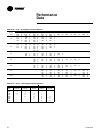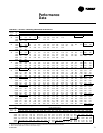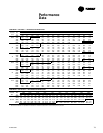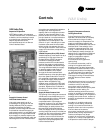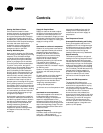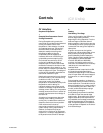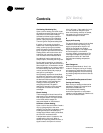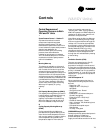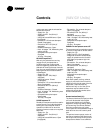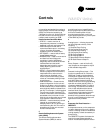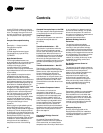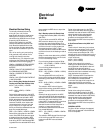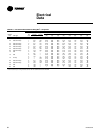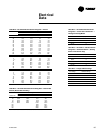
RT-PRC010-EN78
Gas Heating: Modulating Gas
Upon a call for heating, the UCM closes
the heating contacts, beginning the firing
sequence. First, the heat exchanger
combustion blower begins operation.
Upon positive proving of combustion
airflow, a pre-purge cycle is executed.
Then the ignition sequence takes place.
If ignition is not proven, the ignition
transformer is de-energized. After a time
delay, another pre-purge cycle takes
place, followed by another attempt to
ignite. If ignition fails a second time, the
heating section will be shut down and
locked out until manually reset at the
unit mounted Human Interface Panel.
As additional heat is required, the air
damper opens, increasing the firing rate.
During heating operation, an electronic
flame safety control provides continuous
flame supervision. If combustion should
become unstable for any reason, heating
will automatically shut down. After one
minute, another 60 second pre-purge
and ignition cycle begins.
As the heating requirement is satisfied,
the UCM will reduce the combustion air,
and the firing rate will lower to maintain
the desired outlet temperature. When
the requirement is fully satisfied, the
heating contacts are opened, de-
energizing the heat. The specific
sequence of operation of the gas heat
will depend on the size of the heat
exchanger.
Electric Heating
The three stages of electric heat will be
sequenced on the zone demand signal
from the zone sensor. The signal is sent
to the UCM and the stages are
sequenced based on load demand.
Hot Water or Steam Heating
Upon a call for heat, the UCM will send a
varying voltage signal to the valve
actuator. The valve will modulate to meet
building demand as indicated by the
voltage signal. When heating is satisfied,
the valve will modulate closed.
A temperature sensor is located on the
coldest section of the coil. When it
senses an impending freeze condition, a
signal is sent to the hydronic valve to
drive it full open. If the supply fan is on,
or if the outside air damper is open
when this freezing condition is sensed,
the supply fan is turned off and the
outside air damper is closed.
B
Supply Air Tempering
For gas and electric heat units in the Heat
mode but not actively heating, if the
supply air temperature drops to 10 F
below the Occupied zone heating
temperature setpoint, one stage of heat
will be brought on to maintain a
minimum supply air temperature. The
heat stage is dropped if the supply air
temperature rises to 10 F above the
Occupied zone heating temperature
setpoint.
C
Auto Changeover
When the System Mode is “Auto,” the
mode will change to cooling or heating
as necessary to satisfy the zone cooling
and heating setpoints. The zone cooling
and heating setpoints can be as close as
2 F apart.
2
Unoccupied Zone Temperature Control
Cooling and Heating
Both cooling or heating modes can be
selected to maintain Unoccupied zone
temperature deadbands. For
Unoccupied periods, heating,
economizer operation or compressor
operation can be selectively locked out at
the Human Interface Panels.
Controls
(CV Units)



